Math & Mandalas
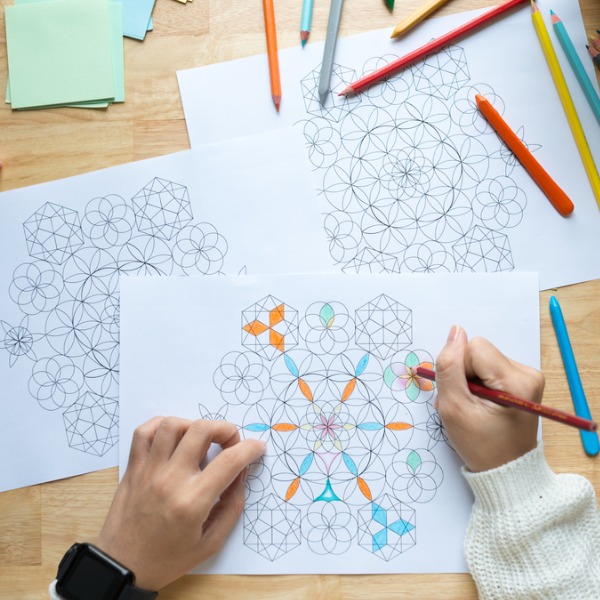
Student colouring a mandala (DragonImages, iStockphoto)
In this lesson, students explore the connection between arts, math and mindfulness as they create mandalas.
Overview
In this lesson, students explore the connection between arts, math and mindfulness as they create mandalas. Creating mandalas is an excellent way to increase student focus and use math in a creative way.
Timing
One hour or two periods of 30 minutes. This activity can be done in the classroom or online, in a synchronous or asynchronous manner.
Learning Objectives
Students could:
Math
- Use geometrical shapes and associated vocabulary
- E.g., circle (concentric), triangles and other polygons, symmetry, angles, patterns, etc.
- Apply geometrical knowledge of circles and other shapes to design a mandala
Arts
- Discuss the significance of colour, self-expression, and symbolism
- Learn about mandala patterns used by different civilizations
Self-awareness / Mental Health
- Learn that art can be a way to practice active mindfulness
- Learn by experience how focusing can help relieve stress
Social Sciences/Humanities
- Learn about principles and meditative art in Tibetan Buddhism.
Creating mandalas is also ideal as an early art activity as:
- it develops fine motor skills;
- anyone can create one, no matter their level of artistic skills;
- parameters help students with low artistic confidence to explore their creativity and appreciate the aesthetic result of their own doing.
Mandalas are a well-known form of art, usually associated with Buddhism. As a form of creative meditation, it is more accessible to young students who might find it hard to practice other forms of more passive mindfulness techniques.
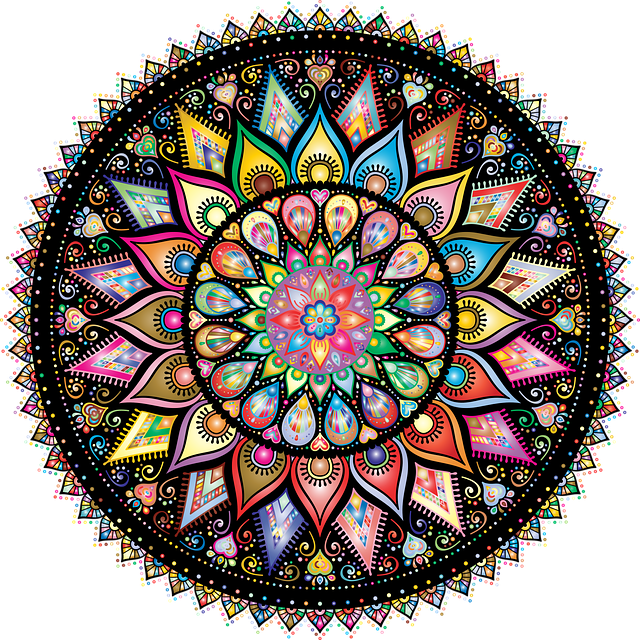
From a teaching standpoint, they also offer great potential to introduce or recall geometrical shapes and concepts such as symmetry and patterns. These two concepts are also popular elements in art, making this a perfect way to combine arts, math and mental health, resulting in a great product that students would want to share with others and be proud of.

Note on Cultural Appropriation
Although present in many cultures throughout history, mandalas can be considered traditional Buddhist and Hindu artifacts. Thus, using this activity in the classroom needs to be done in a respectful manner by acknowledging its origins and in presenting its main objective as an introspective activity. This is supported by the first steps for the What to Do: Minds-On section below.
Materials and Preparation
- Symmetry, Patterns & Mandalas presentation [Google slides] [pdf]
- Choice of a calm musical background long enough to last through the activity. Alternatively, you can play mandala drawing videos in the background to inspire students. This playlist from Let’s Talk Science can be used.
Each student will need:
- Paper or Mandala Template Activity Booklet and template reproducible [Google doc] [pdf]
- Pencil
- Colouring pencils or markers
- Compass (optional, for older students)
What to Do
Minds-on
Teachers can introduce the activity by first sharing the 3 main aspects with students.
- Introduce or remind students that stress can affect our mental and physical health. Active mindfulness activities can help them with anxieties and benefit their capacity to focus. This can be done with a quick discussion on how students experience and deal with stress in their own lives.
- Introduce the origins and significance of mandalas across civilizations. While appreciating these different works of art, also point out the use of shapes. Help students recognize the repetitive patterns as important elements of art. This can be done using this slideset by Let’s Talk Science.
- Finally, inform students that this activity will also allow them to get creative with math by including geometrical shapes and repetitive patterns. Teachers will need to introduce the principle of radial symmetry and patterns, both of which are also introduced in the slideset.
Symmetry is an important way to distinguish groups of animals and plants. Most animals that people are familiar with have bilateral symmetry, which means that both sides are similar. But sea stars are an example of radial symmetry. Sea urchins have pentaradial symmetry, which means they have 5 segments, including a beak formed by 5 teeth!

Hands-on
Steps below offer a variety of differentiated options for different grades. Teachers should select and present those to their students according to students’ capacities and learning objectives.
1. Introduction to the Meaning of Colours
Colours are often associated with concepts and emotions. Many references exist on these associations, but because these can differ culturally, it is best to let students choose what they feel is appropriate.

2. Drawing the Circle
This can be done in various ways depending on the student's level and focus on learning outcomes desired. Teachers can use the Mandala Template Activity Booklet and template reproducible provided to guide this activity.
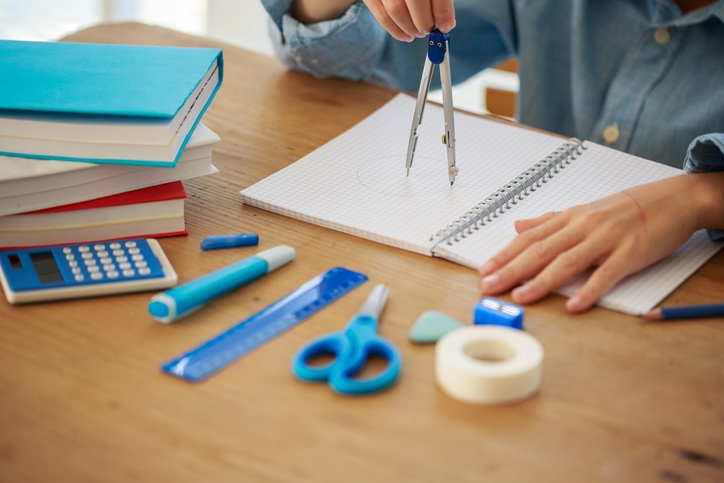
- Teachers can provide a template with a pre-drawn circle.
- Younger students could use a ready-made shape in cardboard to trace their own circle.
- Ask students with a geometry kit : “How do you think you could draw your mandala? What tool would you use?”
- Older students could be asked to draw a circle of a defined area, circumference or diameter (E.g., A circle with a surface area of 314 cm2 or a circumference of 62 cm can be given if using common letter-sized sheets of paper).
- Older students could be asked to use a digital tool to create their mandala.
3. Creating Lines for Radial Symmetry
This can be done in various ways depending on the students’ level and focus on desired learning outcomes.

- Teachers can provide a template with a pre-drawn, divided circle.
- Younger students can be asked to fold their circle in 2 (for 4 sections, recommended for kindergarten) or 3 (for 8 sections, recommended for older students) to create the separations. If not cut, this will involve having the circle printed or drawn in the centre of the sheet of paper.
- Teachers can scaffold student drawing of the diameter lines and concentric circles (E.g., identify the centre of their circle, then measure the same distance from the centre on each diameter line to guide where the circle will be).
- Older students can be asked to separate their circle into 45 degree slices.
4. Additional geometry criteria & drawing
Below are lists stating examples of criteria that can be included in the drawing activity, for different grades. But remind students that these are minimal criteria, they also need to let their creativity fill the circle around these elements. There are millions of ways to fill their mandala!
Examples for primary students:
- Make sure to repeat the same pattern in the 4 sections.
- Include one triangle and one square in your pattern.
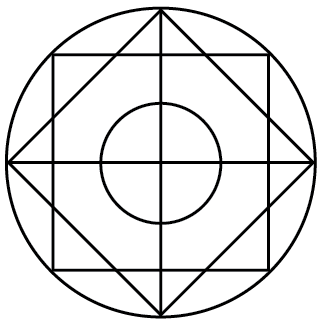
Examples for middle school students:
- Include a minimum of 2 concentric circles
- Include a circumscribed square
- Include at least one right angle triangle, one equilateral triangle and one parallelogram.
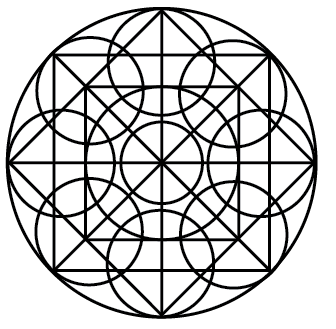
5. Initial State of Mind
Once criteria are established, ask students to use one side of the paper to write how they feel as they begin to create their mandala. This will allow students to reflect on the effect of creating their mandalas. This will also be done at the end of the drawing sessions. An emotion chart can be used with younger students. Kindergarten students can be asked to complete an emoticon to indicate their state of mind. Older students could be asked to write one or two sentences.

6. Drawing Time
You can choose to do this in silence but smooth, calm music can also be played. You can tell students to simply pay attention to their thoughts and feelings while drawing, or you can tell them to focus on something they desire, such as finding a solution to a problem, or better understanding of a situation, or simply thinking about something they like.
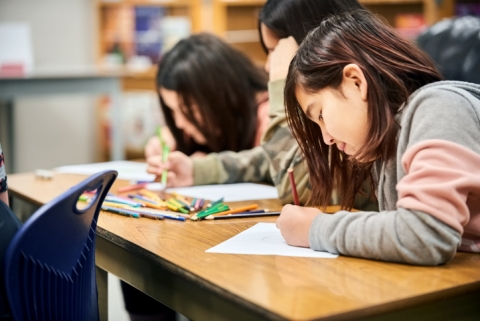
7. Final reflection
Once students have completed their mandala, have them reflect on how this activity affected them. This can be done using the third page of the reproducible template.
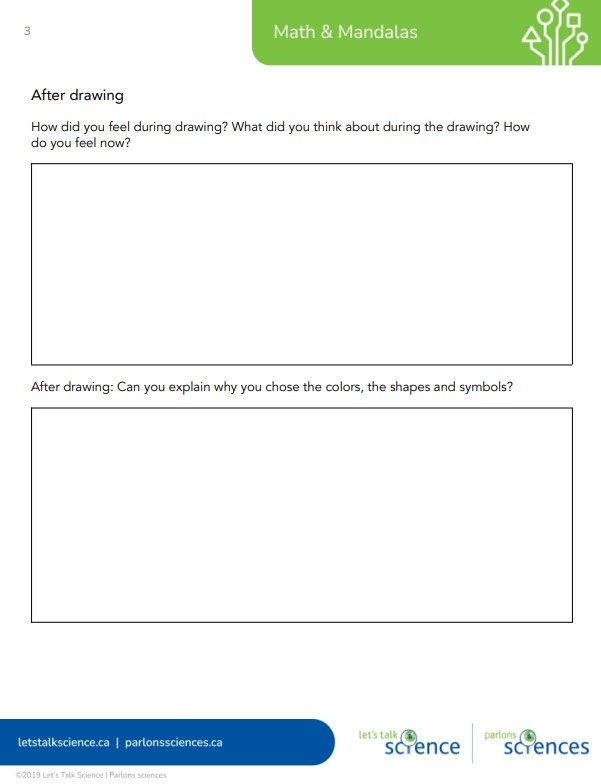
Details
Sand Mandala for Dalai Lama's 80th Birthday (2015)
This video (2:03 min.) by UC Irvine presents the principles of creation of a sand mandala.
The Science Behind Nature’s Patterns
This article, with a slideshow, presents the science behind patterns seen in nature.
The complex geometry of Islamic design (2015)
This video (5:06 min.) by TedEd presents the islamic traditional arts involving geometry and tessellations.
Indigenous basket-weaving makes an excellent digital math lesson (2019)
This article relates a pedagogical activity involving patterns in traditional Salish basket weaving and the use of digital tools in the modern classroom.
Social Emotional Learning Activities Using A Mandala
This article by kiddiematters.com offers additional information on how to integrate social emotional learning in a mandala creation activity.
Mandala – meaning of beautiful Shapes & Colours
This article by BrainArt presents the significance of Colours and symbols in mandalas.
The Geometry of Music (2017)
This video (2:41 min.) by The Harmonagon Project illustrates the link between geometry and music, as initiated by Pythagoras.
Geometric Design: A Celtic Grid (2015)
This page offers a tutorial to draw celtic designs using geometry.
- Mandalas can be created using natural objects in an outdoor setting.
- Students could be challenged to find the value of pi by taking measurements of different mandalas.
- High school teachers could use mandalas as a way to introduce and explore Thales’ theorem.
- Variations: older students could do a digital montage to develop their digital arts skills.
Making Connections
- Students learn to recognize the connections between different maths and the arts.
- Students learn about the use of symbols and colour in art.
- Students learn to make connections with their mental health using a mindfulness exercise.
Planning
- Students learn that art can involve planning.
- Students learn to plan their piece by considering elements they need and want to integrate.
Comparing
- Students learn how an art form or technique has evolved different cultures around the world.
Reflecting
- Students learn to reflect on their own practice.
- Students learn to reflect on math and how it is used in ways they might be familiar with.
- Symmetry, Patterns & Mandalas presentation [Google slides] [pdf]
- Mandala Template Activity Booklet and template reproducible [Google doc] [pdf]
Mika, C. (2020, April 19). Mandala- It’s all about the Math. The Art of Education.
Learn More
Sand Mandala for Dalai Lama's 80th Birthday (2015)
This video (2:03 min.) by UC Irvine presents the principles of creation of a sand mandala.
The Science Behind Nature’s Patterns
This article, with a slideshow, presents the science behind patterns seen in nature.
The complex geometry of Islamic design (2015)
This video (5:06 min.) by TedEd presents the islamic traditional arts involving geometry and tessellations.
Indigenous basket-weaving makes an excellent digital math lesson (2019)
This article relates a pedagogical activity involving patterns in traditional Salish basket weaving and the use of digital tools in the modern classroom.
Social Emotional Learning Activities Using A Mandala
This article by kiddiematters.com offers additional information on how to integrate social emotional learning in a mandala creation activity.
Mandala – meaning of beautiful Shapes & Colours
This article by BrainArt presents the significance of Colours and symbols in mandalas.
The Geometry of Music (2017)
This video (2:41 min.) by The Harmonagon Project illustrates the link between geometry and music, as initiated by Pythagoras.
Geometric Design: A Celtic Grid (2015)
This page offers a tutorial to draw celtic designs using geometry.
Extending the Learning
- Mandalas can be created using natural objects in an outdoor setting.
- Students could be challenged to find the value of pi by taking measurements of different mandalas.
- High school teachers could use mandalas as a way to introduce and explore Thales’ theorem.
- Variations: older students could do a digital montage to develop their digital arts skills.
Assessment
Making Connections
- Students learn to recognize the connections between different maths and the arts.
- Students learn about the use of symbols and colour in art.
- Students learn to make connections with their mental health using a mindfulness exercise.
Planning
- Students learn that art can involve planning.
- Students learn to plan their piece by considering elements they need and want to integrate.
Comparing
- Students learn how an art form or technique has evolved different cultures around the world.
Reflecting
- Students learn to reflect on their own practice.
- Students learn to reflect on math and how it is used in ways they might be familiar with.
Downloads
- Symmetry, Patterns & Mandalas presentation [Google slides] [pdf]
- Mandala Template Activity Booklet and template reproducible [Google doc] [pdf]
References
Mika, C. (2020, April 19). Mandala- It’s all about the Math. The Art of Education.